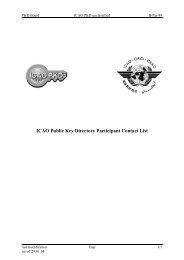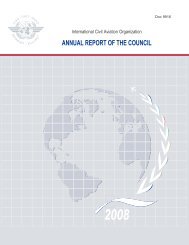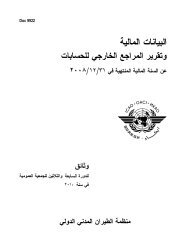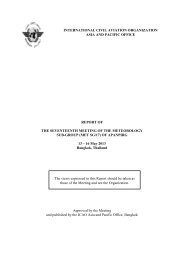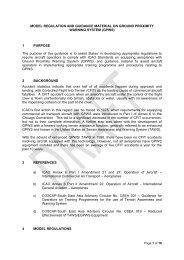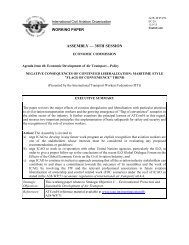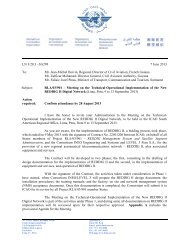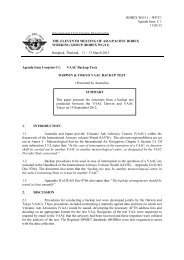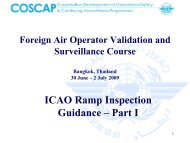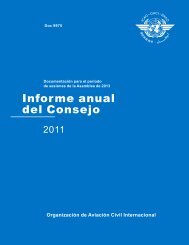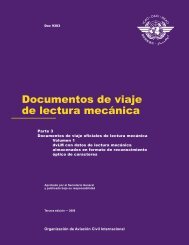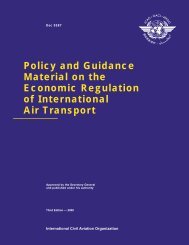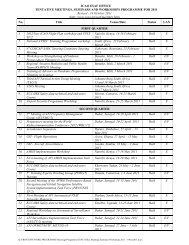afi met bulletins exchange (ambex) handbook - ICAO
afi met bulletins exchange (ambex) handbook - ICAO
afi met bulletins exchange (ambex) handbook - ICAO
Create successful ePaper yourself
Turn your PDF publications into a flip-book with our unique Google optimized e-Paper software.
AFI Regional SIGMET Guide Page10/60<br />
3. PROCEDURES FOR PREPARATION OF SIGMET INFORMATION<br />
3.1 General<br />
3.1.1 SIGMET information is prepared in abbreviated plain language using approved <strong>ICAO</strong><br />
abbreviations, a limited number of non-abbreviated words, geographical names and numerical values of<br />
self-explanatory nature. All abbreviations and words to be used in SIGMET are given in Appendix D.<br />
3.1.2 The increasing use of automated systems for handling the MET information by the<br />
aviation users makes it essential that all types of OPMET information, including SIGMET, are prepared<br />
and transmitted in the prescribed standardized formats. Therefore, the structure and format of the<br />
SIGMET message, as specified in Annex 3, Part II, Appendix 6, which provides detailed information<br />
regarding the content and order of elements in the SIGMET message, should be followed strictly by the<br />
MWOs.<br />
3.1.3 SIGMET is intended for transmission to aircraft in flight either by ATC or by VOLMET<br />
or D-VOLMET. Therefore, SIGMET messages should be kept conciseand clear without additional<br />
descriptive text other than the prescribed in Annex 3.<br />
3.1.4 After the issuance of a SIGMET the MWO should maintain watch over the evolution of<br />
the phenomenon for which the SIGMET has been issued and issue updated SIGMET when necessary.<br />
The TC and VA SIGMET should be updated at least every 6 hours.<br />
3.1.5 SIGMET should be promptly cancelled when the phenomenon is no longer occurring or<br />
no longer expected to occur in the MWO’s area of responsibility. The SIGMET is understood to cancel<br />
itself automatically at the end of its validity period. If the phenomenon persists a new SIGMET message<br />
for a further period of validity should be issued.<br />
3.2 Types of SIGMET<br />
3.2.1 Although Annex 3 provides one general SIGMET format, which encompasses all weather<br />
phenomena, it is convenient when describing the structure and format of the messages to distinguish<br />
between three types of SIGMET, as follows:<br />
- SIGMET for en-route weather phenomena other than VA and TC (this includes:<br />
TS, CB, TURB, ICE, MTW, DS and SS); this SIGMET will be referred as WS<br />
SIGMET;<br />
- SIGMET for volcanic ash, which will hereafter be denoted as VA SIGMET or WV<br />
SIGMET; and<br />
- SIGMET for tropical cyclones, which will hereafter be denoted as TC SIGMET or<br />
WC SIGMET.<br />
3.2.2 The three types of SIGMET can be identified by the data type designator included in the<br />
WMO abbreviated heading of the SIGMET message, as explained below.<br />
3.3 Structure of the SIGMET message<br />
3.3.1 A SIGMET message consists of:<br />
- WMO heading – all SIGMETs are preceded by an appropriate WMO heading;<br />
September 2007 Amend1/2010 Ninth Edition



